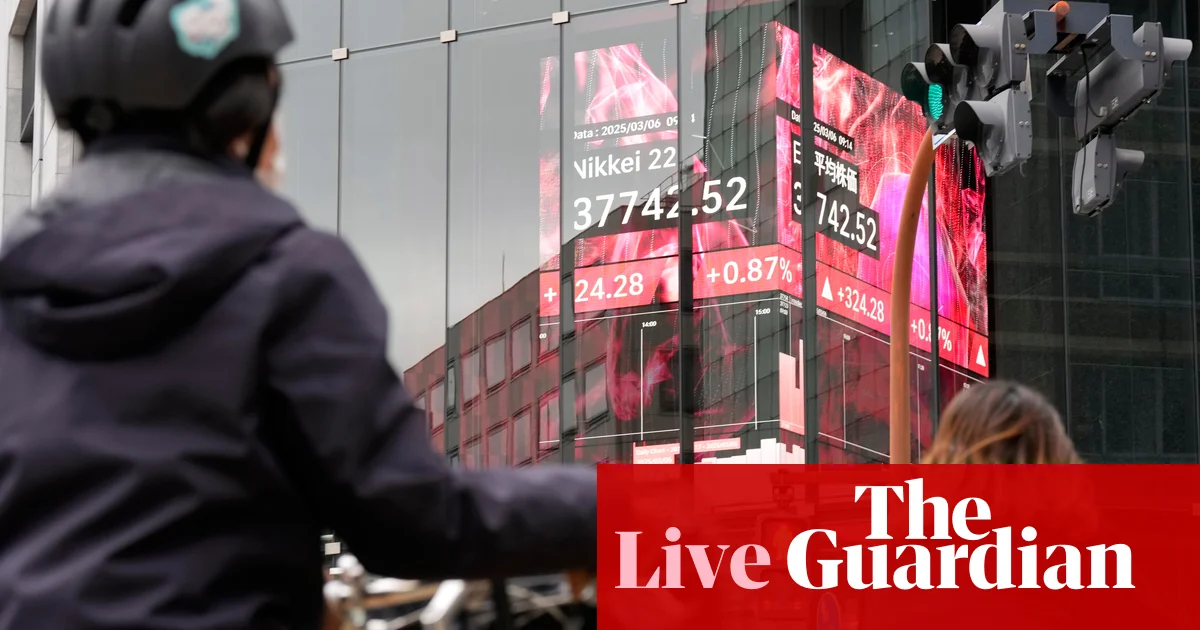Show key events only
Please turn on JavaScript to use this feature
Show key events only
Please turn on JavaScript to use this feature
Tokyo’s Nikkei index has opened 3.4% down after the Trump tariffs, while Australian shares are down 2%.
Nikkei average futures were also down 6% in the minutes before opening, Reuters reported.
In Australia S&P/ASX 200 index fell as much as 2.1% to 7,768 points by 0002 GMT. The benchmark recorded its biggest intraday loss since December 19, 2024.
“Stocks are diving following Trump unveiling tariffs that will hurt most global companies, Australian farmers, and investors alike”, said Jessica Amir, a market analyst at trading platform Moomoo.

Eva Corlett
New Zealand will face a 10% baseline tariff on all imported goods into the US, as part of Donald Trump’s sweeping worldwide tariffs announcement.
The announcement has puzzled New Zealand, which says the US administration’s claim that New Zealand imposes a 20% tariff rate on US goods does not add up.
Roughly 75% of goods from the US into New Zealand have low or no tariffs imposed, while tariffs levied on US imports is about 1.9% on average. New Zealand’s trade minister Todd McClay told media on Thursday:
New Zealand applies a much lower tariff rate for US exports into New Zealand – I’ve asked officials to clarify, but we don’t have a 20% tariff.
The US is New Zealand’s fastest growing export market, becoming its second largest in 2024, ahead of Australia and after China. New Zealand exports to the US surpassed NZD $9b in 2024, driven by meat, dairy and wine. The new tariff could mean a NZD $900m bill for New Zealand exporters.
McClay said the imposition of tariffs was not unexpected but it would have an impact on New Zealand exporters, some of which may look to other markets. McClay said:
Tariff rates anywhere upon New Zealand exporters is not a good thing … but New Zealand exporters are very nimble, and they are very able and very competitive.
New Zealand would not be looking to retaliate with tariffs on the US, McClay said.
That would put up prices on New Zealand consumers, and it would be inflationary.
The price of gold hit a new record after the tariff announcements.
Gold crossed the previous record of $3,149.14 an ounce at around 2300 GMT on Wednesday and then continued to climb above $1,350 an ounce, as traders piled into the safe haven asset amid a steep decline in stock market futures.
The Japanese yen has strengthened 1% against the US dollar on Thursday, AFP reports.
In morning trade in Tokyo, one dollar bought 147.69 yen, with the Japanese currency – traditionally viewed as a safe-haven – up 1% compared to late Wednesday.

Lisa O’Carroll
Strongly. The EU has already announced a string of tariffs it plans to introduce on US imports targeting steel and aluminium in kind, as well as textiles, leather goods, home appliances, house tools, plastics and wood.
Sources say it is also considering nuclear options, including tariffs on revenues generated in the EU by big tech firms and social media.
This could be seen as highly provocative and would put Trump’s allies, such as Elon Musk and Jeff Bezos, in the crosshairs. It would also test the unity of the EU, with Ireland expected to argue against more punitive measures because of the dominance of the US tech sector in Dublin.
Any action by the EU – which is targeted with a 20-percent tariff rate – “should be proportionate, aimed at defending the interests of our businesses, workers and citizens,” said Irish prime minister Micheál Martin.
Italian prime minister Giorgia Meloni on Wednesday called the new US tariffs on the EU “wrong”.
The EU’s preference is to negotiate so it has decided to delay countermeasures to open a space for talks. Maroš Šefčovič, the European commissioner for trade and economic security, has already met the US commerce secretary, Howard Lutnick, and, although Šefčovič reportedly came home last week “empty handed”, he is operating the Brexit playbook, hoping to build a personal relationship that will provide credit in the bank when they get down to talks.
EU chief Ursula von der Leyen is expected to give a reaction on behalf of the European Commission – which handles trade issues for all 27 countries in the European Union – at around 0300 GMT on Thursday – that’s in three hours – during a visit she is making to Uzbekistan.
The US tariff rate on all imports has rocketed to 22% from just 2.5% in 2024 under the new global levies imposed by President Donald Trump, Fitch Ratings’ U.S. economic research chief said on Wednesday. Reuters reports:
“That rate was last seen around 1910,” Olu Sonola, Fitch’s head of US economic research, said in a statement after Trump’s announcement for a global baseline import tax of 10%, but much higher rates for many trading partners.
“This is a game changer, not only for the US economy but for the global economy,” Sonola said. “Many countries will likely end up in a recession. You can throw most forecasts out the door, if this tariff rate stays on for an extended period of time.”
Hello and welcome to our live coverage of reaction to the latest Trump tariffs, which were more aggressive than expected against major US trading partners and which sent shockwaves through global markets.
“This is the worst-case scenario that the market was expecting and that’s enough to potentially send the US into a recession,” said Jay Hatfield, CEO at Infrastructure Capital Advisors.
Speaking in the White House Rose Garden against a backdrop of US flags on what he called “Liberation Day”, Trump slapped sweeping 10% tariffs on imports from around the world.
He also unveiled particularly stinging tariffs of 34% on China, 20% on the European Union and 24% on Japan, saying they were “nations that treat us badly.”
He also hit some of the world’s poorest countries and those struggling with wars and natural disasters: Myanmar, which is embroiled in civil war and which was struck last week by a devastating earthquake, was hit with tariffs of 44% while Sri Lanka was hit with rates of 44%, Bangladesh a rate of 37%, Cambodia 49% and Syria 41%.
“For decades, our country has been looted, pillaged, raped and plundered by nations near and far, both friend and foe alike,” Trump said.
Wall Street was closed when Trump made his announcement but the S&P index was down 1.5% in after-hours trading. The dollar fell 1% against the euro as he was speaking, but then recovered.
US stock futures fell on the announcement, with S&P 500 E-minis down 3.5%, while the euro was down 0.3%. Markets in Asia are beginning to open now. We’ll bring you all the latest developments as they happen.
In the meantime, here’s what you need to know:
- The 10% universal tariff will go into effect on 5 April while the reciprocal tariffs will begin on 9 April.
- Special exceptions were made for Canada and Mexico, though the countries were previously targets of proposed broad tariffs. The White House said that goods covered by an existing trade deal with Canada and Mexico will continue to see no tariffs.
- Trump said the US would charge half of the fees he feels trading partners unfairly impose on the US because the US people are “very kind”.
- Trump zeroed in on the industry-specific tariffs countries have placed on American exports. In his speech, Trump criticized policies like the EU’s ban on imported chicken, Canadian tariffs on dairy and Japan’s levies on rice.
- The new tariffs come on top of a lineup of levies that Trump has already implemented: an additional 20% tariff on all Chinese imports and a 25% tariff on all steel and aluminum imports. There is also a 10% tariff on energy imports from Canada.
- Sweeping auto tariffs of 25% that Trump announced last week are also due to take effect at 12:01 am (0401 GMT) on Thursday.
- US Treasury Secretary Scott Bessent warned nations not to impose countermeasures, saying on Fox News: “If you retaliate, there will be escalation.”
- Leaders around the world criticised the tariffs, with Australian prime minister Anthony Albanese calling them “totally unwarranted” and his Italian counterpart, Giorgia Meloni, a close Trump ally, saying they were “wrong”.
